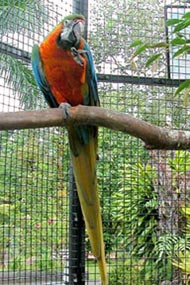Because
there is a demand for this species for the pet trade, most breeders
hand-rear the young. Hand-reared Hahn’s tend to be quite demanding and
unless taught the usual commands (such as “Step up!”) from an early age
will soon try to dominate humans. It is essential that a young bird is
taught this, especially as I would never recommend wing-clipping. All
young Parrots have a great need to fly and if prevented from doing so,
not only will their muscles fail to develop properly (possibly making
flight in later years impossible) but psychological problems such as
feather plucking can result. Note that a parent-reared bird will be
less dependent on human company and better able to amuse itself if left
alone. It should therefore be less noisy than a more demanding
hand-reared youngster. If removed from the parents about four weeks
after leaving the nest, its pet potential will be good in the hands of
a patient person who enjoys the challenge of taming. This is achieved
by spending much time talking to it and not handling it until it is
confident.
Hahn’s
Macaws are easy to feed. A quality Parrot mixture that contains a good
variety of items should be offered, avoiding those that contain cheap
fillers like hard maize and flaked peas -- inedible to most Parrots.
They enjoy
spray millet.
They will consume various vegetables, cooked maize and fresh corn,
green beans, the berries of hawthorn and all the usual fruits. When
chicks are in the nest an egg
rearing food can be offered with the addition of frozen (thawed) mixed vegetables sprinkled with a
calcium supplement.
Young, tender corn on the cob will be greatly appreciated, especially
by recently fledged or hand-reared young at the weaning stage.
Sprouted sunflower seed that has just started to germinate is another
excellent food.




